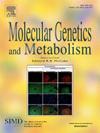Angelman综合征患者脑脊液中UBE3A蛋白检测的新方法
IF 3.7
2区 生物学
Q2 ENDOCRINOLOGY & METABOLISM
引用次数: 0
摘要
神经元中泛素蛋白连接酶E3A (UBE3A)的产生缺失导致Angelman综合征(AS)。目前可靠测量脑脊液(CSF)中UBE3A的方法有限,这对治疗发展产生了负面影响。为了克服这一差距,我们开发并分析验证了一种新的脑脊液UBE3A定量方法,其中包括免疫沉淀蛋白捕获步骤,然后是胰蛋白酶消化和高分辨率质谱检测一种独特的UBE3A肽。我们的数据表明,我们可以可靠地检测到浓度低至2.5 pg/mL的UBE3A。该实验表明,UBE3A可以在健康成人和AS患者的脑脊液样本中检测到。正如预期的那样,健康成人脑脊液UBE3A水平(24.76±6.75 pg/mL, N = 14)显著升高(p <;0.01)高于两个AS组(5.30±0.42 pg/mL, N = 19和5.59±0.40 pg/mL, N = 10)的脑脊液UBE3A水平,两个AS组间UBE3A水平无显著差异。在两个队列中,携带突变或染色体缺失的AS患者的脑脊液UBE3A水平也没有显著差异。总的来说,这些数据证明了这种新型CSF UBE3A测定法在AS研究中用于UBE3A定量的实用性。本文章由计算机程序翻译,如有差异,请以英文原文为准。
Novel method for detection of UBE3A protein in CSF from individuals with Angelman syndrome
Loss of production of ubiquitin protein ligase E3A (UBE3A) in neurons leads to Angelman Syndrome (AS). There are limited methods to reliably measure UBE3A in cerebrospinal fluid (CSF), which negatively impacts therapeutic development. To overcome this gap, we developed and analytically validated a novel method for CSF UBE3A quantitation, which includes an immunoprecipitation protein capture step followed by tryptic digestion and high-resolution mass spectrometry detection of a unique UBE3A peptide. Our data suggest that we can reliably detect UBE3A at concentrations as low as 2.5 pg/mL. The assay was used to show that UBE3A could be detected in CSF samples of both healthy adults and patients with AS. As expected, CSF UBE3A levels in healthy adults (24.76 ± 6.75 pg/mL, N = 14) were significantly higher (p < 0.01) than the CSF UBE3A levels measured in two AS cohorts (5.30 ± 0.42 pg/mL, N = 19 and 5.59 ± 0.40 pg/mL, N = 10), with no significant difference in UBE3A levels observed between the two AS cohorts. There was also no significant difference in CSF UBE3A levels when comparing AS patients carrying either a mutation or chromosomal deletion in either cohort. Overall, these data demonstrate the utility of this novel CSF UBE3A assay for UBE3A quantitation in studies of AS.
求助全文
通过发布文献求助,成功后即可免费获取论文全文。
去求助
来源期刊

Molecular genetics and metabolism
生物-生化与分子生物学
CiteScore
5.90
自引率
7.90%
发文量
621
审稿时长
34 days
期刊介绍:
Molecular Genetics and Metabolism contributes to the understanding of the metabolic and molecular basis of disease. This peer reviewed journal publishes articles describing investigations that use the tools of biochemical genetics and molecular genetics for studies of normal and disease states in humans and animal models.
 求助内容:
求助内容: 应助结果提醒方式:
应助结果提醒方式:


